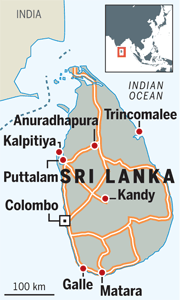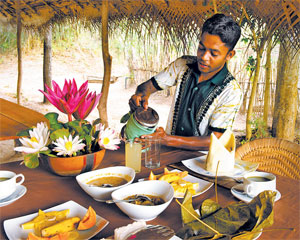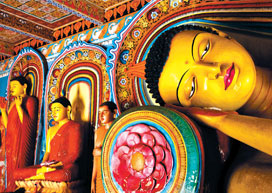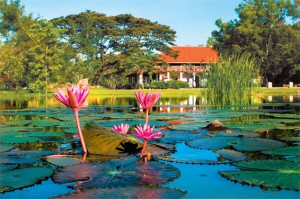Sri Lanka: War-torn beauty
After 30 years of violence, northern Sri Lanka is opening up to tourism
Saying I’m going on holiday to Sri Lanka elicits one of two reactions from my friends. There’s the ooh-elephants-temples-cocktails-at-sunset-lucky-you! brigade. And
then there are my friends who read the newspapers. “Which beach did you say you’re staying on?” emails a friend. “The one where Sri Lankan forces massacred civilians? Or the one with the death camps?”
Uneasy
Hmm. It’s a fair point. It’s just two years since government forces finally routed the Tamil Tigers: a brutal end to a brutal war. Anyone who saw War Crimes Unpunished , a shocking documentary shown on Channel 4 last week, will be feeling very uneasy about putting the words “Sri Lanka” anywhere near a sentence which also includes “holiday” and “destination”.
But there’s an argument that it should be the government that is punished and not the people. And if you share my belief that tourism is largely a force for good, re-balancing global economics, stimulating investment and helping rebuild communities, then, as I discovered in Lebanon in the early 1990s and Sarajevo a few years later, the aftermath of war is in some ways the best time to go.
Not to be flippant
I don’t want to be flippant – I can’t be after seeing Channel 4’s footage of executed children – but going to the war-affected parts of the country, in the north and east, rather than swigging cocktails with the elephants-and-sunsets brigade in the south, seems somehow more appropriate. Locals are delighted to see you, there is a dearth of other tourists, and when I look up one of our first destinations – Kalpitiya – in the index of the Lonely Planet guide, I have a moment of quiet joy when I discover it’s not actually there. It’s that rarest of all rare things: a place where Lonely Planet has yet to tread.
Treasured island
There’s just a handful of quiet, low-key hotels, most of them like the one we’re staying at, the Bar Reef resort, with its simple “rooms” built out of wood and palm fronds with open-air beds lit by oil lamps at night. We like being in the open air, although some people might say it’s something of a bold move to build a hotel next to the sea and deliberately ensure that none of your rooms have a sea view. Still, it’s all very eco, which is not surprising when you consider that the owners also run Sri Lanka’s best-known yoga retreat, Ulpotha.
Rustic
The rustic simplicity doesn’t come cheap, yet a streak of hippy thinking still runs through the place: we eat a dinner of home-cooked curries communally on our knees in the central gazebo with the other guests. There’s the cool ice maiden I nickname “Gillian Anderson”. Her partner looks like Tony Blair. And then there’s the international expat crew: the Germans who live in Delhi; the Australians from Kuwait; the Brits from Singapore. “My friend in the embassy in Colombo told me it was the secret place for those in the know,” the German lady tells me.
It’s only two days later that I discover that the woman I nicknamed Gillian Anderson actually is Gillian Anderson. “Good God,” I say, wondering if I’ve missed the scoop of the century. “Tell me that wasn’t actually Tony Blair?” It wasn’t, but I can’t help thinking coming here is a smart move on Anderson’s part: the Bar Reef resort is the antithesis of a five star hotel stuffed with paparazzi.
Razor wire
Along the beach there are old watch towers, barracks and forgotten rolls of razor wire. Offshore, the water teems with fish and thousands of leaping dolphins (deep-sea
fishing was banned for years because of security issues). There are whales, too, further out – the continental shelf is just a few miles offshore and it was only recently discovered that this is a major migration route for sperm whales, blue whales and minkes.
We miss the whales but it doesn’t matter: it’s such a sleepy forgotten place with fishermen’s shacks next to the hotel and local boys playing cricket on the beach. However, it’s a way of life that’s about to change: war may have preserved Kalpitiya but it looks like peace will get it instead. The government has an extensive development plan involving dozens of hotels and, worse, “an amusement park, golf course, racecourse and a domestic airport” are all planned. If you’re going, go now.
Up in the hills
Until now, most investment in Sri Lanka has been local and limited. Up in the hills outside Kandy, we meet David Swarbrick, a British publisher, and Mikael Zoghbi, a Swedish headhunter, who bought a 45-acre plantation while the war raged on.
“It was a bit mad buying a hotel in a war zone, but we just fell in love with it,” says Zoghbi. Together they have restored the land and will open a new boutique hotel, The House of the Flame Trees, next year.
Slowly improving
According to Swarbrick, things are slowly improving and post-war normality is re-emerging. But it’s Sri Lanka’s lack of development during those years that forms part of its charm. Swarbrick grew up in Calcutta, “and it reminds me here of how India used to be, before everyone was in such a rush.”
But then rushing is not an option. Bicycles, tuk-tuks, schoolchildren in white pressed uniforms, cars and trucks all share a single carriageway and manoeuvre around each other with something like grace (or perhaps simply good fortune). Mohammed, our Tamil driver, takes us along the A12 to Anuradhapura, the old Sinhalese capital. There’s a land-that-time-forgot quality to the drive. We see no suburbanisation and no shopping malls.
Unspoiled
It’s unspoiled and barely touched by the modern world, even though Anuradhapura is the heart of Sri Lanka’s so-called cultural triangle, a Unesco world heritage site
stuffed full of temples, stupas and ancient caves. We hire bikes and cycle from one empty complex to the next, dodging only Sinhalese pilgrims and cows in the road.
But then Anuradhapura was – and still is – an important military base and supply route. North of here was Tamil Tiger country; south was government-controlled. Several bomb attacks, including one in 2008 which killed around 30 people, deterred tour groups from visiting. Today, it’s mostly backpackers and day-trippers who make the journey, though there’s now a stylish hotel, the Ulagalla resort, with individual villas set in 60 acres of lush jungle just to the south. It’s an upmarket honeymoon type resort where you can cruise the grounds on electric golf buggies.
Tiger country
Even here, in what looks very much like paradise, it’s only recently that it’s been safe to visit. “This was all Tiger country,” the hotel’s manager tells us.
It’s the heart of Sri Lanka’s “dry zone”, a spectacularly misleading description for what turns out to be a very wet landscape. The next day we head east, past hundreds of “tanks”, or lakes, which are sophisticated rainwater harvesting systems built hundreds of years ago, a system that ensures dazzlingly green paddies and lush forest.
A few miles outside of Anuradhapura, the road narrows to a single track pitted with potholes and the number of military checkpoints and barracks increases. It’s the main road to Trincomalee, north-east Sri Lanka’s biggest town, off-limits for years, its hinterland a former Tiger stronghold. We pass watch-towers, burned out buildings, shacks built with the assistance of the UN, the EU and the Red Cross. The area around Jaffna, in the far north, was where the alleged war crimes took place but this road was the frontline.
There’s a military barracks every kilo metre or so – all quiet now, though Mohammed points out that “nothing has actually changed”. The reasons why the war started – at least partly down to the Tamil’s frustration over their lack of access to education – still exist today, he says.
Poorer and poorer
As the land gets poorer and poorer, the houses little more than mud huts with tin roofs, it’s easy to understand Mohammed’s point. “Look at it! There’s nothing for young men here. They prefer to die.”
And yet it’s starkly beautiful. There’s nothing but jungle and soldiers and extraordinary bird life. I’ve never had bird-watching tendencies before but in Sri Lanka I
discover my inner twitcher. The birds prove impossible to ignore: wild peacocks roost in trees next to the road, huge green kingfishers perch on telephone wires, cranes and spoonbills rest in the paddies, pelicans and storks swoop overhead.
Appalling
According to Google maps, it should take less than two hours to travel the 70 miles to Trincomalee. But it takes us at least five. The road is appalling. When we arrive at the Chaaya Blu hotel and talk to Lankesha Ponnamperuma, its manager, he cheerfully explains that “the road to Colombo is even worse.”
The Chaaya Blu is a relaxed and cheerful place. It’s a true survivor, built in a burst of optimism in the 1970s and staying open throughout the war. The topography of the coastline has protected it from the worst of the 2004 tsunami, and it was given a facelift in another burst of optimism around a year ago. Business was brisk during the war with NGOs and aid workers. It’s peacetime that’s proving trickier. “They talk about attracting tourists,” sighs Ponnamperuma, “but that road … ”
Diaspora has returned
In the meantime, the diaspora has returned: sturdy Australian Sri Lankans raised on milk and beef who’ve come to see their ancestral homeland. Despite the peace, a militaristic culture is still apparent everywhere. At the end of the beach and on the mouth of the creek – in a prime position where a boutique hotel would stand if we were in any other part of the world – is a spectacularly sited police post. Even the town’s major sight, a Hindu shrine high on a cliff overlooking the harbour, is bang in the middle of a barracks.
Lovely
Still, it’s a lovely, sleepy relaxed sort of place, where cows amble along the beach, and girls in pretty floral frocks wave as you pass them in the street. In the late afternoon, we wander between stupas and temples where “puja”, or ceremonial offering, is performed, a riot of bell-ringing and drum-banging. It feels as though we are the only tourists for 200 miles in any direction, and I can’t help thinking that everyone else is missing a trick.
The next day we bump back down the potholed road. (When has anywhere worth visiting been easy to get to?) We spend our final night in the Mud House, which really is a mud house, or at least a collection of mud houses in the middle of the jungle. It’s tourism at its best: small-scale, low-tech and eco-friendly. The foreign investors and giant corporate chains are gathering at the borders, though. So go now: after the war, but before the concrete mixers arrive.
……………………………………………………………..
Carole Cadwalladr was a guest of Experience Travel, who offer tailor-made tours to all parts of Sri Lanka. A 13-day tour like that described would cost £2,095, including private chauffeur/guide for the duration, activities, entrance fees and most meals. Flights from London would add £660; www.experiencesrilanka.com
See original article here : http://www.ft.com/cms/s/2/6807c624-6c5b-11e1-b00f-00144feab49a.html?ftcamp=published_links/rss/life-arts/feed//product#axzz1pKxA8WcJ




